Home gardening
How to grow a garden at home?
Planting and harvesting at home is accessible to all, proper care and the needed materials are required for the garden to be a success. Growing your own vegetables is a way to eat healthy, have a nutritious and balanced diet. In addition the enjoyment of having your own harvest food and a dynamic activity for the whole family.
You have to choose vegetables adapted to local climate conditions. Among many details it is important to have organic matter, i.e. compost, which will help enrich the nutrients of the soil. Keeping the soil aerated, free of weeds, watching for pests and diseases are some of the chores that you will gradually learn with practice and the caring for plants.
For example, a tip to keepthe soil free of weeds is to have a layer of bark to protect the soil from local conditions.
Home gardens are usually for personal consumption, so it is recommended to have a space of 90 x 90 cm wide and 20 cm deep. On many occasions you can share or create an exchange with your community; in which not only the resultisdivided, but alsohelp create a sense of collectivity and environmental responsibility.
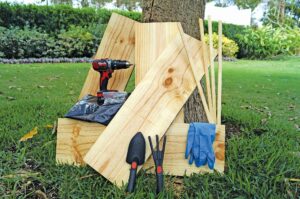
Photography: Ana María Icaza
A very simple system to create a home garden is described step by step. It is very important to consider that each climate and ecosystem is different; you have to carefully observe the growth and care of plants in the region. The following is required:
- 4 tables of 20 cm x 90 cm.
- 4 wooden slats of 5 cm x 90 cm.
- 32 wood screws of 1¼ inches.
- 1 sturdy plastic bag.
- 1 screwdriver or drill.
The box is assembled using the wood, is lined inside with the plastic bag that is slightly pierced to let irrigation flow.
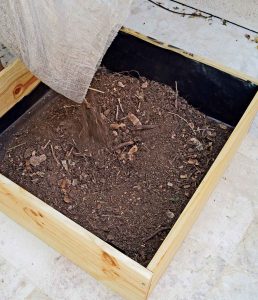
Photography: Ana María Icaza
THE SUBSTRATE
It is important that the materials where plants will grow are evenly chosen, allowing the plant to receive all necessary components and nutrients. That is why, it’s recommended to include a kilogramof compost, two kilogramsof soil and a bag of dry leaves (sack of 46 x 75 cm). These materials are uniformly mixed and spread on the previously prepared wood box. To give an ideal texture and achieve oxygenation, you need to move the earth.
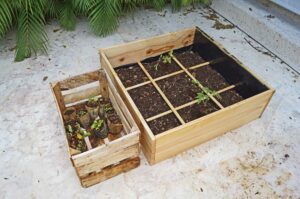
Photography: Ana María Icaza
How do I organize planting?
Sowing depends heavily on the size of the plant; this determines the separation between them. For example, in a square of 30 x 30 cm a seed of tomato must be placed or 4 seeds oflettuce, celery, beet or chard. In another square 9 seeds of onion or parsley can be placed, or 16 cilantro, scallion or radish seeds.
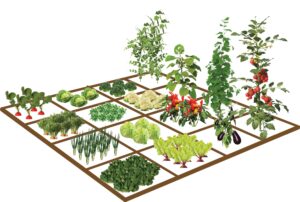
Illustration: Luisi Icaza
Each plant grows differently and different cares are needed, for example in some cases such as the tomato, needto have “tutors” for the plant to go climbing and facilitate harvest.
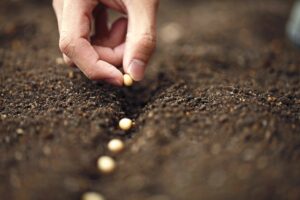
Photography: Ana María Icaza
Seeding plants is usually very simple, just make a hole in the soil, insert the seed and cover loosely without compressing the ground.
To avoid pests and diseases theuse ofphysical or biological barriers can help, place wire meshes or structures that delimit seeding, always making sure that they are not invasive.
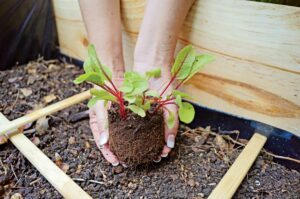
Photography: Ana María Icaza
It’s time to harvest!
The most rewarding moment is when you can eat the delicious foods that your garden produced.
The newly created garden will serve for many crops, it is important to rotate the seeds to achieve healthy and nutritious plants.
Crop rotation is an effective method that will let you keep planting in the same spot, in addition avoid plant pests.
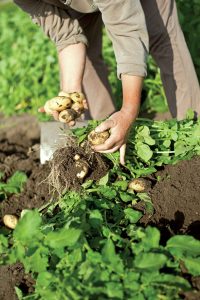
Photography: Ana María Icaza
THE IRRIGATION
Irrigation is one of the most important aspects, excess or shortage of water should be avoided in the garden. It is recommended to water dailythe garden late in the afternoon; this will help maintain the substrate humid as long as possible to achieve adequate hydration.
Placing the garden in a sunny place is indispensable, where it is constantly receiving sunlight. Avoid placing it under trees or next to walls that make shade, the sun is a key element for the garden and without it there is no growth.
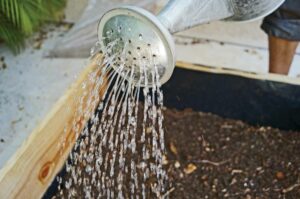
Photography: Ana María Icaza
COMPOST AND ITS SIGNIFICANCE
Compost is a type of homemade fertilizer obtained from the accelerated decomposition of organic matter. It is made with organic waste such as vegetables, eggshells, seeds, grass, dry leaves, paper, ash, etc.
It is not recommended to include meat, bones, dairy products or dog and cat wastes.
Compost helps to fertilize and enrich the soil of the gardens, as well as being an effective way to get rid of organic household waste.








